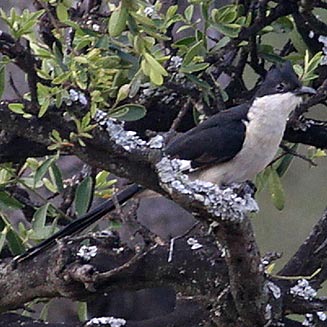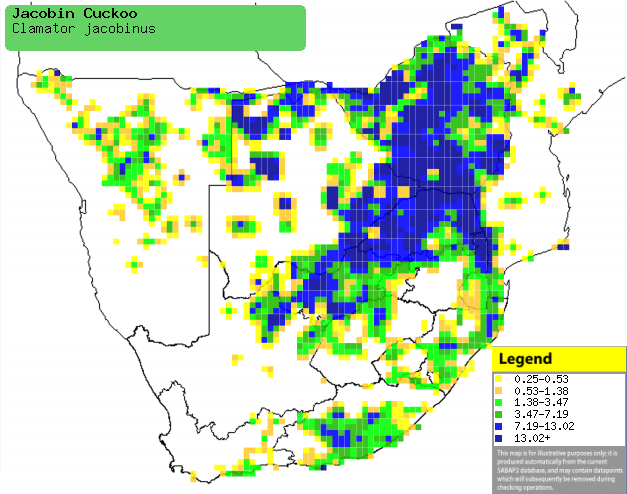|
Clamator jacobinus (Jacobin cuckoo)
Bontnuwejaarsvoël [Afrikaans]; Ilunga Legwaba [Xhosa]; iNkanku [Zulu];
Montoe-phatšoa [South Sotho]; Inkanku [Swazi]; Tihunyi (also applied to
Levaillants cuckoo) [Tsonga]; Jacobijnkoekoek [Dutch]; Coucou jacobin
[French]; Jakobinerkuckuck, Elsterkuckuck [German]; Cuco-jacobino
[Portuguese]
Life
> Eukaryotes >
Opisthokonta
> Metazoa (animals) >
Bilateria >
Deuterostomia > Chordata >
Craniata > Vertebrata (vertebrates) > Gnathostomata (jawed
vertebrates) > Teleostomi (teleost fish) > Osteichthyes (bony fish) > Class:
Sarcopterygii (lobe-finned
fish) > Stegocephalia (terrestrial
vertebrates) > Tetrapoda
(four-legged vertebrates) > Reptiliomorpha > Amniota >
Reptilia (reptiles) >
Romeriida > Diapsida > Archosauromorpha > Archosauria >
Dinosauria
(dinosaurs) > Saurischia > Theropoda (bipedal predatory dinosaurs) >
Coelurosauria > Maniraptora > Aves
(birds) >
Order: Cuculiformes > Family: Cuculidae
 |
 |
|
Jacobin cuckoo, Tanzania. [photo
Martin Goodey
©] |
Jacobin cuckoo (dark form), Polokwane Game
Reserve, South Africa. [photo Trevor Hardaker ©] |
The Jacobin cuckoo is fairly common and widespread, with a
occurring from India to Arabia south to large areas of southern Africa. It is a specialist, feeding mainly on
caterpillars, foraging by hopping from branch to branch, snatching insects from
the foliage. It is a brood parasite, laying its eggs in other birds nests
(usually bulbuls). It lays 1 egg per nest, laying
a total of about 25 eggs in one breeding season. The chick hatches after an
incubation period of about 11-13 days, remaining in the nest for roughly 17
days. It learns to fly soon after leaving, becoming fully independent at about
33 days old.
Distribution and habitat
Fairly common and widespread, with occurring from India to Arabia
south to sub-Saharan Africa, avoiding equatorial lowland forest. In southern
Africa it is fairly common in central and northern Namibia, Botswana, Zimbabwe,
Mozambique and South Africa (largely excluding the arid Karoo). It generally prefers
Acacia and mixed savanna woodland, but it may also occupy valley bushveld,
coastal forest and Miombo woodland.
|
 |
|
Distribution of Jacobin cuckoo in southern Africa,
based on statistical smoothing of the records from first SA Bird Atlas
Project (©
Animal Demography unit, University of
Cape Town; smoothing by Birgit Erni and Francesca Little). Colours range
from dark blue (most common) through to yellow (least common).
See here for the latest distribution
from the SABAP2. |
Call
Movements and migrations
Intra-African breeding migrant,
with complex movements across its distribution range. It normally arrives in
southern Africa in October to breed, and usually leaves by April, although it sometimes
stays for the rest of the year.
Food
Feeds mainly on
caterpillars, doing most of its foraging by hopping from branch to branch, snatching insects
from the foliage. The following food items have been recorded in its diet:
Breeding
- It is a brood parasite, meaning that it lays its eggs
in other birds nests. The host, thinking that the egg is its own, incubates
the egg and cares for the chick. The following bird species have been
recorded as hosts of the Jacobin cuckoo:
- Major hosts (in order of importance)
- Minor hosts (In random order)
- Egg-laying season is from
October-April, peaking from November-January.
- It lays one egg per nest,
laying a total of about 25 eggs in one breeding season. Both sexes are
involved in egg-laying - the male perches near the host's nest, calling
loudly in order to get the attention of the hosts away from the female. She
in the meantime flies into the nest, lays an egg and flies out again,
usually abstaining from destroying the hosts eggs.
- The chick hatches after an
incubation period of about 11-13 days, remaining in the nest for roughly 17
days. It learns to fly soon after leaving, becoming fully independent at
33 days old.
Threats
Not threatened.
References
-
Hockey PAR, Dean WRJ and Ryan PG (eds) 2005. Roberts
- Birds of southern Africa, VIIth ed. The Trustees of the John Voelcker
Bird Book Fund, Cape Town.
|
